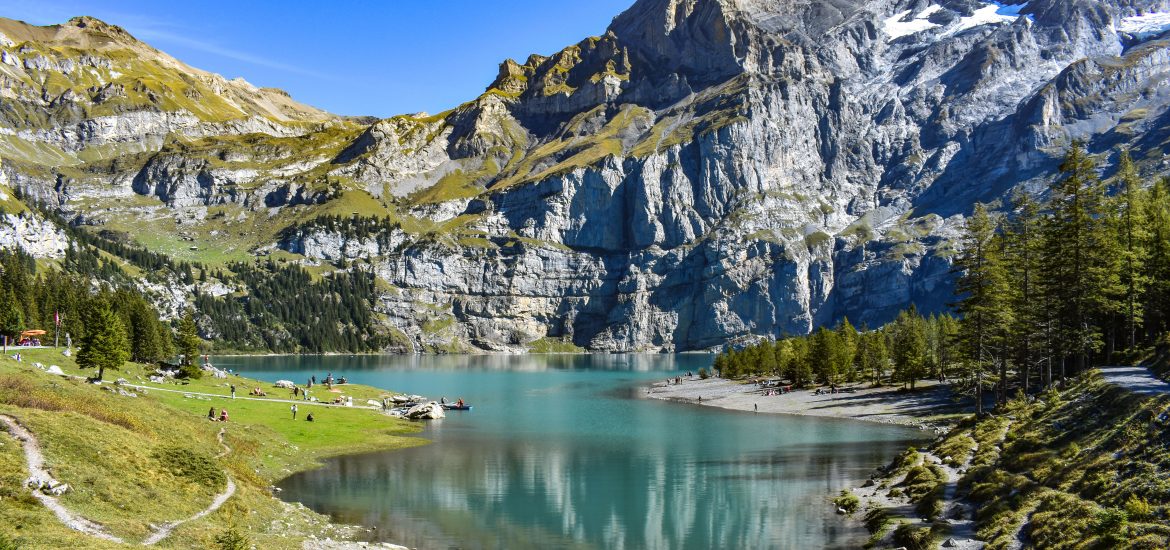This is part of a series of posts dedicated to the exploration of Swiss Alps Jungfrau-Aletsch-Bietschhorn, a UNESCO World Heritage site covering an entire area of 82,400 ha. The next few paragraphs will be about the site’s universal value (the reason why it is inscribed on the World Heritage list) and a brief introduction to various viewpoints, hiking trails and attractions in different regions in and around the inscribed area. If you have already read other posts related to the property, please click here to jump directly to the main content of this one.
As the UNESCO comments:
The extension of the natural World Heritage property of Jungfrau-Aletsch-Bietschhorn (first inscribed in 2001), expands the site to the east and west, bringing its surface area up to 82,400 ha., up from 53,900. The site provides an outstanding example of the formation of the High Alps, including the most glaciated part of the mountain range and the largest glacier in Eurasia. It features a wide diversity of ecosystems, including successional stages due particularly to the retreat of glaciers resulting from climate change. The site is of outstanding universal value both for its beauty and for the wealth of information it contains about the formation of mountains and glaciers, as well as ongoing climate change. It is also invaluable in terms of the ecological and biological processes it illustrates, notably through plant succession. Its impressive landscape has played an important role in European art, literature, mountaineering and alpine tourism.
自然世界遗产少女峰–阿雷奇冰河–毕奇霍恩峰(最早于2001年被列入)从东部扩展到西部,面积从53 900公顷扩展到82 400公顷。该遗址为阿尔卑斯高山——包括山脉最受冰河作用的部分和欧亚大陆山脉最大的冰川——的形成提供了一个杰出的实例。它以生态系统多样性为特点,包括特别受气候变化冰川融化而形成的演替阶段。该遗址因景色秀美、而且包含山脉和冰川形成以及正在发生的气候变化方面的丰富知识而具有突出的全球价值。在它尤其通过植物演替所阐释的生态和生物过程方面,该遗址的价值无法衡量。其令人难忘的景观在欧洲艺术、文化、登山和阿尔卑斯山旅游中起着重要作用。





In order to be inscribed on the UNESCO World Heritage list, sites must be of outstanding universal value and meet at least one of the ten Criteria for Selection. Swiss Alps Jungfrau-Aletsch-Bietschhorn meets
Criterion (vii): to contain superlative natural phenomena or areas of exceptional natural beauty and aesthetic importance, because the impressive landscape within the property has played an important role in European art, literature, mountaineering and alpine tourism. What’s the top 1 attraction in Switzerland? The Alps. What’s the most famous part of the Alps? The Jungfrau region. The area around Jungfrau, Aletschhorn and Bietschhorn, which includes the imposing north wall of the High Alps featuring Eiger, Mönch and Jungfrau and on the southern side many spectacular peaks and a valley system containing Europe’s largest glacier, is globally recognized as one of the most spectacular mountain regions to visit;
Criterion (viii): to be outstanding examples representing major stages of earth’s history, including the record of life, significant on-going geological processes in the development of landforms, or significant geomorphic or physiographic features, because the property provides an outstanding record of the geological processes that formed the High Alps and is abundant in diverse geomorphological features such as U-shaped glacial valleys, cirques, horns, valley glaciers and moraines. 20 – 40 million years ago, through uplifting and compressing, the formation of the High Alps began. Ranging from 809 m to 4,274 m high, the mountains in the property show 400-million-year-old crystalline rocks thrust over younger carbonate rocks due to the northward drift of the African tectonic plate. As the most glaciated part of the Alps, the site contains the largest and longest glacier in Europe – the Aletsch Glacier, which shows a range of classic glacial features. Furthermore, the glacier provides vital information about glacial history and ongoing processes, in particular related to climate change.
and Criterion (ix): to be outstanding examples representing significant on-going ecological and biological processes in the evolution and development of terrestrial, fresh water, coastal and marine ecosystems and communities of plants and animals, because within the property, diverse flora and fauna are represented in a range of habitats, and plant colonization in the wake of retreating glaciers provides an outstanding example of plant succession. Covering a wide range of altitudes and exposures (such as the dry southern side and wet northern side), the property includes diverse alpine and sub-alpine habitats. On the crystalline and carbonate rocks, a variety of ecosystems have evolved without significant human intervention. Particularly worth mentioning is the upper and lower tree-line of the Aletsch forest, a superb example of plant succession. The global phenomenon of climatic change, which is reflected in the varying retreating rates of the glaciers, is particularly well-illustrated in the region, providing new substrates for plant colonization.

As you can see from the map above, the inscribed area is huge, so how can we explore it? Before giving you some suggestions based on my own experience and the information on www.jungfraualetsch.ch, let’s first learn some facts about the property:
- surface of the World Heritage area: 824 km2
- Population of the World Heritage region: 40,000 inhabitants
- 23 municipalities in the cantons of Valais (15) and Bern (8) are involved
- 9 mountains within the area are over 4000 meters and Finsteraarhorn is the highest peak (4274 m)
- around 50 mountains within the area are over 3500 meters
- the glaciers cover a total area of 350 km2
- the longest and largest glacier in the Alps, Aletsch Glacier (23 km) is located at the center of this protected area
- 88% of this area is without vegetation
- the Bernese Alps (Wetterhorn – Schreckhorn – Eiger – Mönch – Jungfrau – Gletscherhorn – Breithorn – Blüemlisalp) are considered one of the most famous mountain ranges in the world
As you might have noticed, most of the inscribed area is not accessible to normal tourists as it’s made up of either high mountains or glaciers. However, there are many viewpoints on the mountains around the property, most of which are conveniently connected to bus stops or train stations by cable cars. Personally, I strongly recommend the viewpoints within and around the Aletsch Arena, which provide amazing views of the Aletsch Glacier, Aletschhorn, Bietschhorn, Jungfrau, Mönch, Fiescherhorn and so on, and within the Jungfrau region including Grosse Scheidegg, First, Schynige Platte, Männlichen, Jungfraujoch, Schilthorn and so on, from which you can see clearly the northern wall of the High Alps featuring the signature Swiss skyline of Eiger, Mönch and Jungfrau. If you are a hiker, you have many more options and can get a closer look at the World Heritage site. Besides the numerous hiking trails in Jungfrau and Aletsch regions, I recommend you checking out the Lötschental Valley, Kandertal Valley (Gasterntal Valley and Lake Oeschinensee), and Rosenlauital Valley (Rosenlaui Glacier Gorge).
Exploring the regions I mentioned above will probably take you a very long time because they offer numerous viewpoints, hiking trails and attractions, and after that, I believe you will have a very good understanding of the universal value of the property such as its unparalleled beauty, exceptional record of the formation of the Alps, excellent demonstration of diverse geomorphological features and remarkable representation of on-going ecological and biological processes. If you are still not satisfied and want to have a completer experience, try visiting the municipalities of Raron, Eggerberg, Guttanen (Grimselwelt), Innertkirchen and Meiringen, where you will find more activities closely or remotely related to the World Heritage site. I read from the official website that there’s a long tour which allows you to hike around the property and discover and learn about it in 15 stages. The booklet providing relevant information regarding the routes and attractions is called «Key to the Alps», which is unfortunately only available in German. I think, even if you don’t speak German or plan to take the complete tour, the booklet should shed some light on the planning of your own exploration. Alternatively, there is a fold-out map available in English with overview and tips regarding highlights of the World Heritage site. I can send the digital version to you upon request and I’m sure it will also give you some ideas.
- To find out the destinations and highlights recommended by jungfraualetsch.ch please click here.
- To find out the destinations and hiking tours recommended by myswissalps.ch please click here.
As I mentioned above, most of the inscribed area is not easily accessible to normal visitors and some parts of it are not clearly visible from the surrounding viewpoints. How can we gain deeper insights into this mysterious world then? Last but not least, don’t forget to visit the municipality of Naters, where the World Nature Forum Information and Visitor Center of the UNESCO World Heritage site Swiss Alps Jungfrau-Aletsch is located. In order to protect this extraordinary natural heritage and to promote sustainable development of this region, 23 municipalities within the cantons of Bern and Valais together with the Swiss Federation have agreed to work in collaboration. The World Nature Forum (WNF) is the base camp of this commission and its Information and Visitor Center provides us with necessary knowledge about this region and helps to raise our awareness of the importance of its protection. If it’s inconvenient for you to reach the area, you can also learn about it at home. On the official website, 19 thematic brochures (more in German) giving insights into the uniqueness, diversity and beauty of the region are available and can be downloaded as pdf. The thematic brochures are about agriculture and settlement, tourism and traffic, fauna and flora, water, culture, glacier, climate, and mountains while the regional brochures are about Oberhasli, Naters, Lötschental, “Suonen”, Raron – Niedergesteln, Grimselwelt, Kandertal, Grindelwald, Lauterbrunnen, Aletsch Region, and Bellwald.
I hope my introduction above gives you a general idea of why the Jungfrau-Aletsch-Bietschhorn region is so valuable and how to explore and learn about it. In a series of posts about the World Heritage site, I’ll focus on the hikes, viewpoints and tours I experienced and provide you with practical information, tips as well as detailed introduction to the geological and ecological processes, geomorphological features and ecosystems which are related to the property. In this post, I’ll focus on the Oeschinensee (Lake Oeschinen), which is one of the few sites located inside the natural heritage and at the same time conveniently accessible to visitors.
1. Oeschinensee





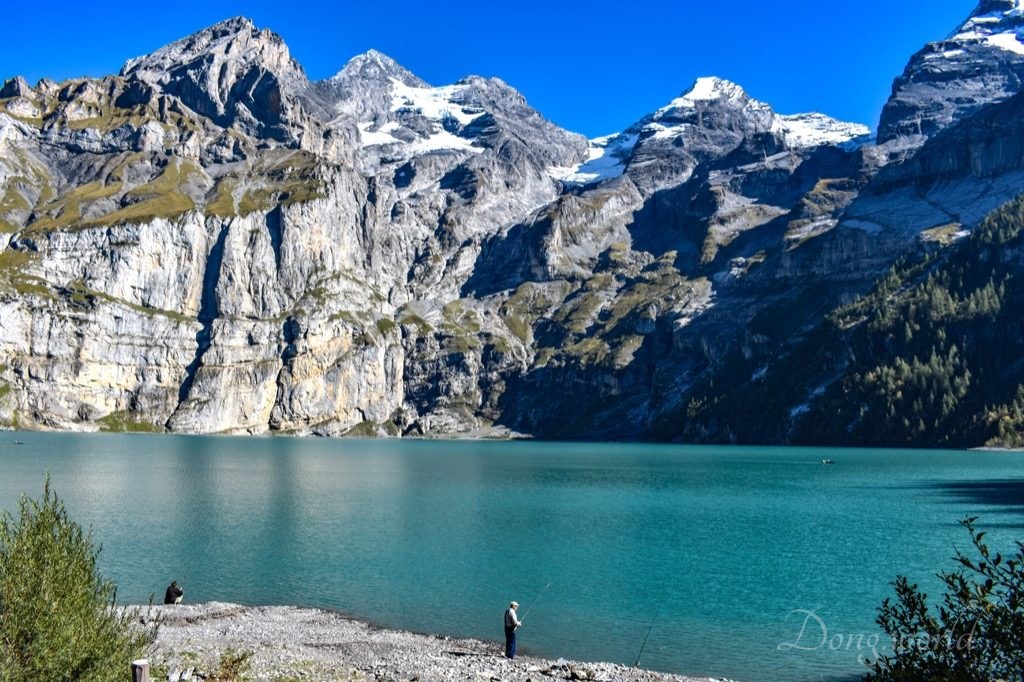
Lake Oeschinen (German: Oeschinensee) is a lake in the Bernese Oberland, 4 kilometers east of Kandersteg. At an elevation of 1,578 m, it has a surface area of around 1.1 square kilometers and maximum depth of 56 meters. The lake is fed through a series of mountain streams such as Oberbärglibach, Öschibach and Doldenhornbach from the surrounding Dündenhorn, Blüemlisalp Rothorn, Blüemlisalphorn, Oeschinenhorn, Fründenhorn and Doldenhorn and drains underground. The water then re-surfaces as the Oeschibach, part of which is captured for electricity production and as water supply for Kandersteg.
As one of the most famous and most photographed lakes in Switzerland, Oeschinensee is a nature reserve inside the UNESCO World Heritage site Swiss Alps Jungfrau-Aletsch-Bietschhorn. For many, it’s the most beautiful lake in Switzerland which offers many activities both in the summer and winter.
In the summer:
- the water temperature can reach 20 degrees, which makes the lake together with its south and west banks an ideal summer resort for swimmers and sunbathers;
- fish in the lake include Arctic char (Seesaibling), lake trout (Kanadische Seeforelle) and rainbow trout (Regenbogenforelle) and with a special permit, which can be purchased directly at the restaurants at Lake Oeschinen, fishing is allowed both from the shore and from the boat. Please note, you need to bring the fishing supplies such as maggots, worms, hooks, rods, and ice augers (if needed) by yourself;
- the lake has been a destination for romantic rowing boat tours for 120 years and the boats can be rented on site. It’s interesting to see and experience the lake from a different perspective;
- it’s possible to do grilling at Oeschinensee and you don’t need to worry about the preparation. Just order by 10:30 on the day of arrival, pick up the complete package (including food and all the necessary items) at Berghotel Oeschinensee and start a fire at one of the grill stations. If the stations are not available, you can also grill along the shore of the lake but remember to maintain a distance of at least 100 m to the edge of the forest and not to start a fire on the pastures;
- hiking is one of the most popular activities in this region and I strongly recommend the Heuberg Panoramic Round Trail, which offers a spectacular view of the UNESCO World Heritage site.
In the winter the lake will be frozen (normally from December to May) and therefore, winter hiking on the shores as well as ice walking, ice skating and ice finishing on the lake is very popular.
After a brief introduction to Oeschinensee and to the popular activities in the region both in the summer and winter, I’ll focus on my own visit to the lake including the panoramic hike. First, let’s see how we can get from Kandersteg to Lake Oeschinen.
2. My own visit
2.1 From Kandersteg to Lake Oeschinen
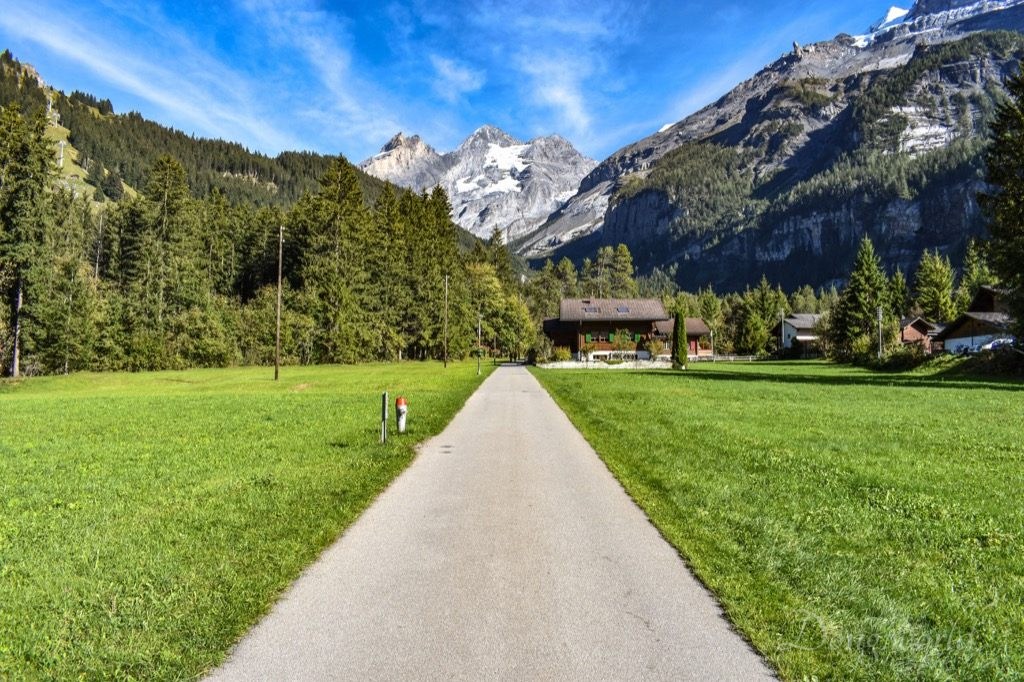




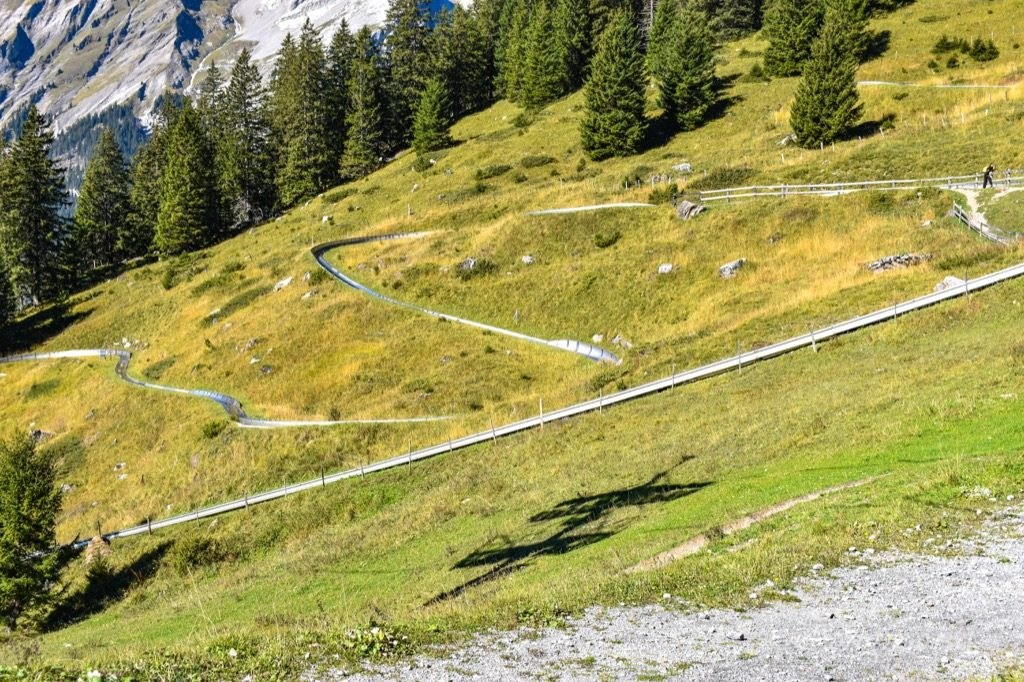



To go from Kandersteg train station to Oeshinensee, there are in general two options. The first one is to hike directly while the second one is to walk, take a cable car and then walk again. As for the first option, there are several hiking routes which take around 1 – 1.5 hours to finish. Either at the information center in Kandersteg or the lower cable car station you can obtain a summer hiking map on which all the trails in this region including how long they are, how difficult they are etc. are marked. It is very practical and made me realize besides Lake Oeshinen, there are many more surprises around Kandersteg. If you plan just to have a relaxing time by the lake with your family or want to save some energy for the Heuberg Panoramic Round Trail, I suggest you go for the second option and take the cable car, which brings you up to Oeschinen in only 10 minutes. You need to walk a bit from Kandersteg train station to the lower cable car station (15 mins) and then from the upper cable car station to the lake (20 mins). What I can assure you is the 35 minutes of walking is magical and it’s no less beautiful than the walk around the lake.
Once getting off the train, I followed the sign and walked in the direction of the cable car station. On the way, the traditional wooden houses, the green grass and trees, the colorful flowers and of course the imposing mountain horns including Blüemlisalp Rothorn (3297 m), Blüemlisalphorn (3663 m) and Oeschinenhorn (3486 m) made me linger. The ride up to Oeschinen was pleasant because the cable cars were in constant operation and though Lake Oeschinen is a very popular attraction, I didn’t need to wait at all. From the upper cable car station, I had a good view of Kandersteg and the Kandertal Valley. What’s famous here is the 750 m alpine toboggan run which brings thrill to children as well as adults. You can ride it alone or with your friend but don’t forget, it’s only open in dry conditions.
- For information about schedule of the cable car please click here.
- For information about ticket prices of the cable car please click here.
From Oeschinen (upper cable car station) to the lake, the road (one of the routes) was scenic. The first part with only meadows on the sides was unobscured, on which I saw clearly the Blüemlisalp Rothorn (3297 m), Blüemlisalphorn (3663 m), Oeschinenhorn (3486 m), Fründenhorn (3369 m), and Doldenhorn (3638 m), while the second part was through a pine forest. If you don’t want to walk, which I think is a pity, shuttle bus is available outside the station and will take you directly to the restaurant by Lake Oeschinen.
2.2 Along the south shore of Oeschinensee



The south shore is a relaxation area where you can go for a swim, fish, have a stroll, sunbathe or have a picnic or grill. It’s very quiet and either by the lake or in the forest, you can find a space and moment belonging only to you and your family. On the way, don’t forget to check out the waterfalls coming from the mountains across the lake. Please note, it’s only possible to walk along the west and south shores of the lake because they do not extend to the north or east sides. Therefore, no matter how far you go along the south shore towards east, you need to return.
Now, let’s walk along the west shore towards north and get ready to start the Heuberg Panoramic Round Trail. On the hiking map, it is written that the trail starts from Läger and goes up to Oberbärgli via Heuberg and then goes down to the lake via Unterbärgli. I’m not 100% sure but I guess it’s also possible to hike the other way round, that is to say, to start from the lake and finish at Läger.
2.3 Heuberg Panoramic Round Trail






Tips
- The Heuberg Panoramic Round Trail is one of the most beautiful hiking trails in Bernese Oberland and the short version of it both starts and ends around Läger. To make the experience completer, you can extend the trail by hiking from Oeschinen -> Läger -> Heuberg -> Oberbärgli -> Unterbärgli -(along the lake west shore of the lake)> Berghaus am Oeschinensee -> Oeschinen. Please note, there’s more than one route between Oeschinen and the lake;
- remember to take the summer hiking map from the information center or cable car station and you can plan your route conveniently;
- both the ascent and descent of the hike are around 400 meters and it takes around 2 hours to finish the short version. If you want to take the complete trail I mentioned above, it takes around 3 – 3.5 hours;
- I would say the difficulty level of the hike is medium and proper hiking boots are a must. According to my experience, several sections were a bit slippery because of mountain stream, rubble or dirt but manageable. You’d better have some experience in hiking and be careful when the road is narrow and close to steep slopes;
- there are a few sheer downward slopes next to the trail, for example on Heuberg, so I don’t recommend the hike for people who are very afraid of height;
- highlights during the hike are views of Lake Oeschinen in its full size and splendor and of the UNESCO World Heritage site Swiss Alps Jungfrau-Aletsch-Bietschhorn;
- you will always have a great view of the lake and surrounding mountains during the hike but the best viewpoints are Heuberg, Oberbärgli and Unterbärgli;
- on the way up, follow the signs to Heuberg and Oberbärgli and on the way down, follow the signs to Oeschinensee. Please note, this is a circular trail so don’t take the same path back;
- on rainy days, access to the trail is limited;
- I hiked on a sunny day (26th September 2018) and the temperature was pleasant. On the way, the sun and exercise made me sweat so I changed from sweatshirt and long pants to t-shirt and shorts, in which I didn’t feel cold at all;
- sun cream is a must for a sunny day;
- by the lake there are two restaurants providing normal meals and at Oberbärgli and Unterbärgli, there are alpine huts providing drinks, snacks and light meals. If you don’t want to go to a restaurant, take some snacks and recharge yourself at some of the viewpoints;
- take enough water with you.
View of the lake on the way





If you don’t want to or are unable to do the hike, I recommend you admiring the lake from its west end, which is close to the rowing boat rental point. One of my main reasons of taking the trail was to have a better view of Lake Oeschinen and along the way, the view was indeed satisfying. During the first 10 – 15 minutes of hiking, my view was partially blocked by the pine trees, but later they weren’t a problem anymore. Due to time limit, I stopped at Unterbärgli and returned. Because I could move my head, it was easy to see the whole lake from there, but when I tried to capture it with my camera, I realized the angle of my lens wasn’t wide enough. In order to take a nice picture of the whole lake, it’s necessary to reach a viewpoint which is higher and further. For example, the highest point of the panoramic hike – Oberbärgli, is a perfect option.
View of the rocks on the way



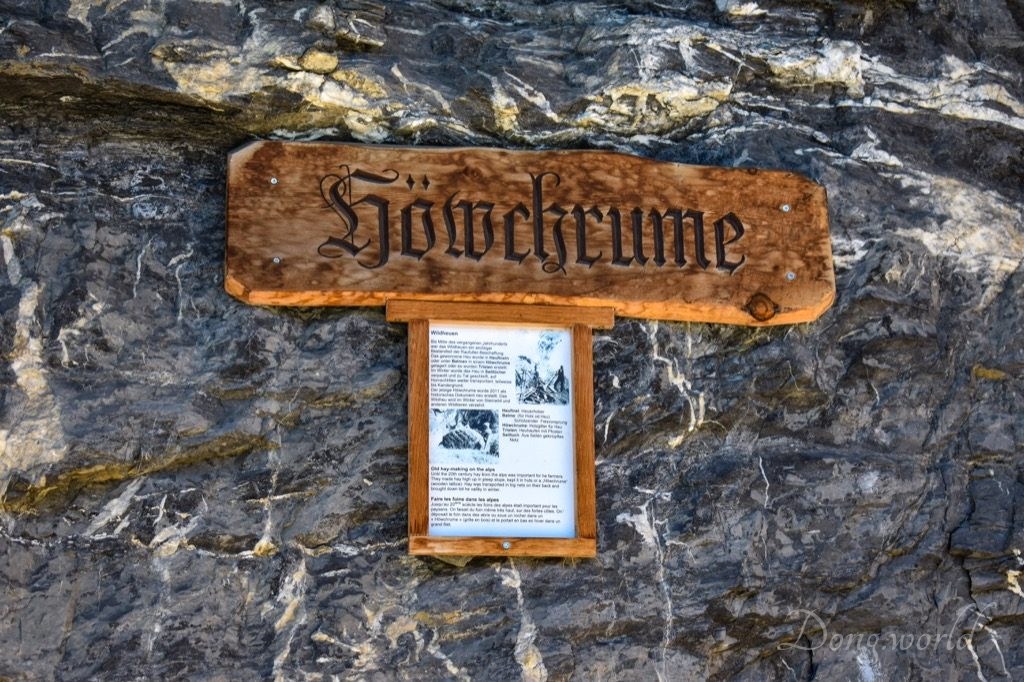
The lake was as attractive as I imagined but the trail, in particular the section between the lake and Unterbärgli, was more thrilling than I expected. Sometimes, the path went through recesses of the cliffs, some of which were quite deep, and I kept asking myself, “What if the huge rocks just fall?” I’m not sure if the recesses were made by humans or nature but it certainly wasn’t an easy task. In one of them, I saw a Höwchrume, which refers to a wooden lattice. It turns out until the middle of the last century, hay from the alps was important for the farmers. They made hay from steep slopes, stored it in a hut or Höwchrume and then in the winter, transported it in a big net on their back down to the valley. Also impressive on the way was the amount of mountain streams and waterfalls. As I learnt from the official website, at the end of the summer, the creeks are usually quite dry, which I guess was the reason why some of the falls were more like jumps of tiny water drops.
As I mentioned at the beginning of the post, the UNESCO World Heritage site Swiss Alps Jungfrau-Aletsch-Bietschhorn covers a huge area (82,400 ha.) and can be admired from numerous viewpoints and explored through many hiking trails and tours. In this post, I focused on the Oeschinensee (Lake Oeschinen), which is a true treasure of the Alps located inside the property. The area around the lake is a perfect destination for relaxation and gatherings of family and friends while the interconnecting trails radiating from it make it a hiking paradise. Particularly worth noting is the Heuberg Panoramic Round Trail, which is manageable (medium difficulty level) and provides spectacular views of not only Lake Oeschinen from above but also the surrounding mountain peaks such as Blüemlisalp Rothorn, Blüemlisalphorn, Oeschinenhorn, Fründenhorn and Doldenhorn, all of which are included in the World Heritage site. In the future, I’ll keep discovering interesting and impressive viewpoints and hiking trails in and around the property, and I’ll make sure to keep you updated. To be continued…
